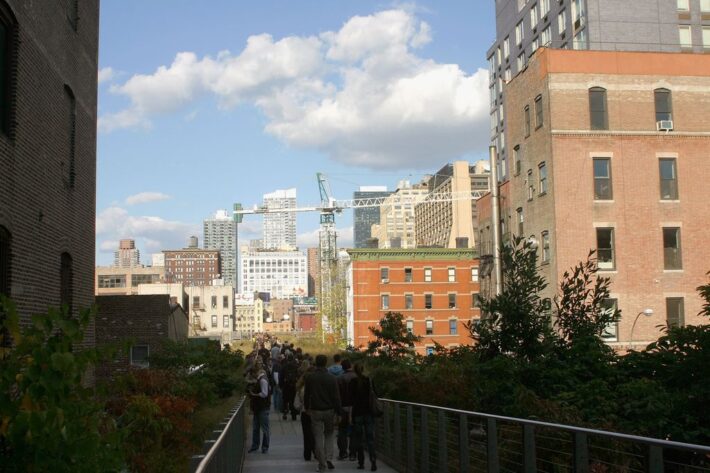
The vacant plot of land on the corner of West 30th Street and Tenth Avenue may not look like much now, but in 2015 it will house a 46-story tower that will become Coach Inc.’s new corporate headquarters. By 2017, the surrounding area will have been transformed into a full-fledged business district.
At least that is the goal of CB Richard Ellis and the Related Companies, the two New York-based commercial real estate firms behind the Hudson Yards Redevelopment Project.
Billed as “New York’s Next Great Neighborhood,” Hudson Yards is a 26-acre complex on Manhattan’s west side bordered by West 42nd and 43rd streets, Seventh and Eighth avenues, West 28th and 30th streets and Hudson River Park. In an effort to maximize space and maintain its connection with the neighborhood, luxury leather goods company Coach announced last November that it would move its corporate offices from West 34th Street between Tenth and Eleventh avenues, where it has been for approximately 50 years, to the site’s South Tower, the first office building at Hudson Yards.
The 1.7 million square foot building will contain Coach’s central buying functions, design functions, and corporate marketing and communications offices and feature direct access to the High Line and adjacent shops and restaurants. The company recently announced that it will hold a minimum of 700,000 square feet—instead of the previously reported 600,000—in the building throughout 15 floors, which will be internally connected by a central atrium and staircase.
“We are a ever-growing company and our space is currently operating at full capacity so the need for additional space is very real,” said Jason Weisenfeld, senior vice president of brand communications at Coach Inc. “The opportunity to be a part of Hudson Yards, and stay in the neighborhood where we have been for almost five decades, and to be part of something as exciting as the development of Hudson Yards and continue our adjacency to the High Line was extremely attractive to us.”
Coach has a longstanding relationship with Friends of the Highline, the non-profit partner to the New York City Department of Parks & Recreation that oversees maintenance of the park, through its sponsorship of Coach’s annual Summer Party on the High Line’s Chelsea Market passage every June. The High Line receives 90 percent of its operating costs from private events, donations and memberships.
Chandra Singh, a 52-year-old Queens resident who works at the Mandarin Oriental Hotel, thinks Coach will continue to do well when it expands to Hudson Yards.
“Anywhere Coach is located they will do very good business because their quality is excellent,” said Singh, at Coach’s store in the Time Warner Center. “They have class, they have style and everything about it is top of the line.”
Other customers, like Kateryna Semenova, a 27-year-old software programmer who lives on the Upper West Side, plan to keep their distance from the High Line’s mid-day tourist congestion. “They need to extend [the] High Line because there are so many people and it’s really sometimes not enjoyable,” she said.
Lorraine Buschhoff, a 38-year-old designer who sells hand-painted miniature Plexiglas paintings on the High Line, thinks Coach’s move will benefit the neighborhood because it will generate business and traffic.
“It’s going to bring tourism, it’s going to bring businesses to the neighborhood, people are going to go to the restaurants, it’s probably going to bring property values up in the long term,” said Buschhoff. “[The Hudson Yards construction] is like the Second Avenue subway: It’s a temporary pain in the ass, but in the long run, it’s probably going to be a good thing.”
Bernie, a 55-year-old resident of the building adjacent to the South Tower’s future location, who preferred not to give his full name due to “possible retaliation from Mayor Bloomberg’s minions,” was not as optimistic. He said the High Line construction lures a lot of people who don’t have the neighborhood’s best interests at heart.
“They leave a mess, they leave garbage all over the street, and they could care less about the neighbors,” he said. “[Hudson Yards] may make it look nice, but it’s going to push the working class person out of the city and then you’re going to have empty streets and businesses going out of business.”
Bernie said that work on the South Tower had created cracks in his building, leveling it an inch and forcing his landlord to replace his ceiling. He said construction has been going on 24 hours a day for the last six months, and nobody from 311 will address his complaints.
According to 311 spokesman Nicholas Sbordone, all complaints taken at 311 are routed to the appropriate city agency for follow-up, and a tracking number accompanies each complaint so the customer can check its status anytime and hold city agencies accountable for their performance.
“311 is no joke,” said Sbordone. “[Complaints] don’t fall through the cracks, [they] get taken and they get tracked.”
The Department of Environmental Protection (DEP), the city agency responsible for Bernie’s complaints, was unable to immediately confirm whether his requests were answered.
Robert Beauregard, professor of urban planning at Columbia University, recommends that local residents not call the DEP, but instead work with neighborhood groups to counteract the exponalities from the construction site.
“City Council is the way to do it. Calling is not as a effective,” Beauregard said.
When asked what effect Hudson Yards will have on the surrounding area, Beauregard replied, “This project’s going to drive up property values around the neighborhood… you’re going to have displacement.”
Hudson Yards may be the next great destination, but it won’t come cheap.